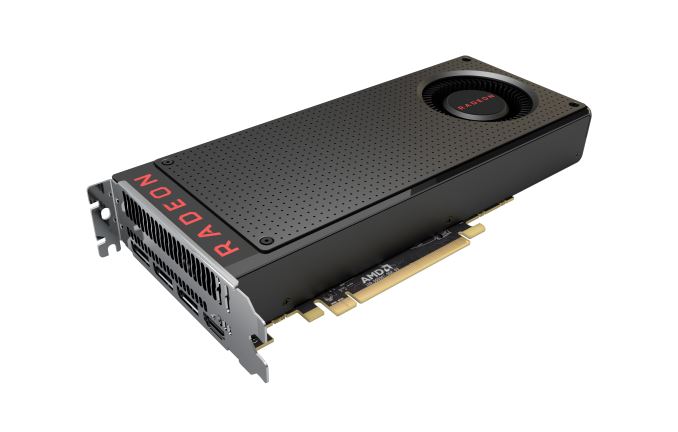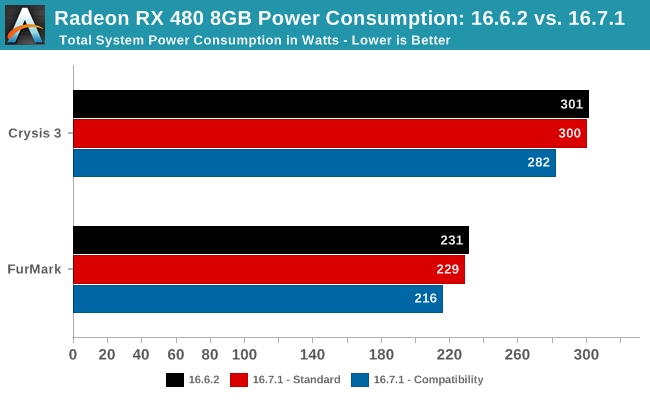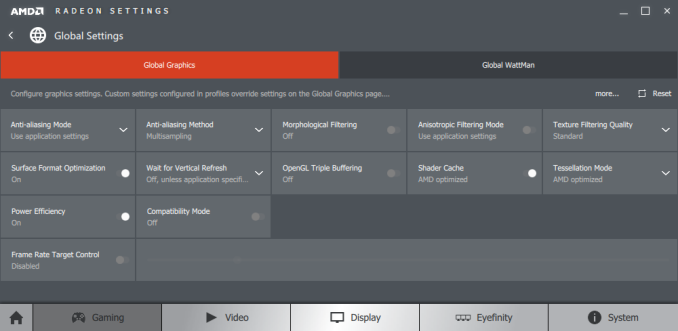AMD Posts Radeon 16.7.1 Drivers, Fixes RX 480 Power Consumption Issues
by Ryan Smith on July 7, 2016 6:50 PM EST
In what’s hopefully the final chapter on AMD’s saga over the last week with the Radeon RX 480’s power consumption, AMD has posted the previously promised 16.7.1 driver set on their website.
As a reminder, 16.7.1 is being released first and foremost to address RX 480’s power consumption issues, in which reviewers found that it was drawing too much power from the PCIe graphics (PEG) slot, and that the total power consumption of the card was at times exceeding 150W, which is the technical limit for a card with a 6-pin power connector. Of the two issues, PEG power consumption is arguably the greater of the two, as the external power connectors are far more forgiving.
To that end, 16.7.1 rolls out a two tier solution to the problem.
- Shift some of the power load off of the PCIe Graphics (PEG) slot connector in order to bring PEG slot power consumption within the PCIe spec. This doesn’t reduce total power consumption and performance is unaffected; power delivery is merely shifted. Based on earlier data this will put the 6-pin connector further over spec, but the vast majority of PSUs are very tolerant of this going out of spec.
- Because total power consumption of RX 480 can still exceed 150W – and as a result also exceed the limits for the 6-pin connector – AMD has also implemented an optional a “compatibility” toggle that reduces the total power consumption of the card. This is to better ensure that both the PEG slot and 6-pin power connector stay below their respective limits. Since the RX 480 is already throttling at times due to power limits, this does hurt performance (more on that below), but it's also the most standards-compliant solution.
Along with the power changes, the driver also incorporates some previously scheduled bug fixes and performance improvements. This includes fixing GTA V stuttering, and small performance boosts for a limited number of games that AMD states should improve performance by up to 3%.
Finally, the 16.7.1 driver can be found on AMD’s website. Note that the driver itself is not WHQL certified, but given AMD’s rush to get it out ASAP, I don’t imagine they were interested in waiting for WHQL certification to come back before releasing them.
Diving into matters then, PC Perspective has already taken a look at the new driver and done individual power rail measurements, finding that AMD’s fixes work more-or-less as advertised. They have found some edge cases where the card is still drawing a watt or two more power from the PEG slot than the specification allows, though at this point we’re arguing over inches. It should be noted however that even in compatibility mode, PC Perspective is still finding that power consumption is technically exceeding 75W on the 6-pin connector, though like the PEG slot by notably less than when not using compatibility mode.
Meanwhile to look at the performance impact of the new driver, I quickly ran our RX 480 through a selection of games at 2560x1440, both with and without compatibility mode.

In standard mode where power consumption isn’t curtailed, performance is essentially unchanged outside of Tomb Raider, which is one of the games targeted for optimization. Essentially this proves that there’s no performance impact from merely shifting power consumption off of the PEG slot to the 6-pin power connector.
Meanwhile in compatibility mode, there is a very small performance hit, though it varies with the game. Compared to standard mode, we’re looking at no more than a 1fps performance drop (~3%), with some games losing only a fraction of a frame per second. That there is a performance drop is consistent – so compatibility mode isn’t free – but overall the performance change is within the +/- 2% margin of error for these benchmarks.

Finally, when it comes to power consumption, measurements at the wall back up our earlier findings. In standard mode, power consumption at the wall bobbles by a couple of watts compared to the 16.6.2 drivers. With compatibility mode on, we see power consumption drop by 18W under Crysis 3, and 13W under FurMark. The average GPU clockspeed in both cases is similarly reduced, with Crysis 3 shaving off around 50MHz.
Anyhow, we’ll have a bit more on the subject in next week’s full Radeon RX 480 review. But in the meantime it looks like AMD has been able to get a handle on their power problems and largely rectify them within the span of a week, making for a fairly quick recovery on the RX 480’s launch fumble.











105 Comments
View All Comments
miribus - Friday, July 8, 2016 - link
If you have a 6+2 pin connector, use that instead of a 6 pin. It has all the power circuits and then you'd be well in spec. Of course that assumes AMD populated all of their power pins on the card, I have no idea, I don't have one. A multimeter would confirm it for you. If all of the 3 power pins on the card show no resistance, plug in a 6+2 power pin, ignoring the +2, and you'll have extra pins to share the load. Also, keep in mind the spec they are talking about is the PCIe spec, not the spec of the components in your system. Depending on quality they're not likely out of spec at all, just the mark the PCIe guys picked. The crimps, pins, wires, can typically go higher, hot rooms or very hot systems become a problem, though. The method above would solve that and nullify the problem entirely for anyone with such a supply (and AMD connecting all pins... I read somewhere that they did.) A simple ugly cable adapter would solve the 6-pin connector issue too (if you don't have a 6+2), bringing the connector into spec.Unless you want to really be pedantic about it sand say that because the +2 pins aren't connected it isn't allowed to carry the 150W, by the letter you're probably right, but I counter with: Look really hard at those +2 pins and notice the tiny wires? They aren't expected to carry any significant load.
extide - Friday, July 8, 2016 - link
Yeah PSU wires are typically good for 8A sustained and easily twice that, or more, for quick bursts. The molex connector is what I would expect to fry first, but even those are rated for 6-8A per pin, I believe. So 3 pins * 6A * 12v = 216w at the minimum would be safe through a 6-pin PEG connector.windozer - Saturday, July 9, 2016 - link
Where'd AMD get this TDP number 150W, when it's actually more?silverblue - Saturday, July 9, 2016 - link
TDP is the thermal design power, not necessarily how much power the card will use, as far as I know. Regardless, with a 20W drop in power, is this 150W figure going to be a problem?Hrel - Wednesday, July 13, 2016 - link
You guys are gonna do all the benchmarking within spec right?Meaning, the lowest scores, compatibility mode?
I would certainly think so, since doing a review based on a card that pushes either the PCI-E rail or PCI-E cable beyond spec is wildly dishonest.
Seems like, when held to spec, the card is actually a bit slower in Crysis and FurMark. So if you do benchmarks in anything other than compatibility mode it should be clearly marked as overclocked and specifically stated, in large bold red font, in the article that this is not within design spec.
Glad to see it's a not drastic impact on performance though.
GTX 1060 numbers are, I'm sure, going to make $240 for that card look like a terrible deal.